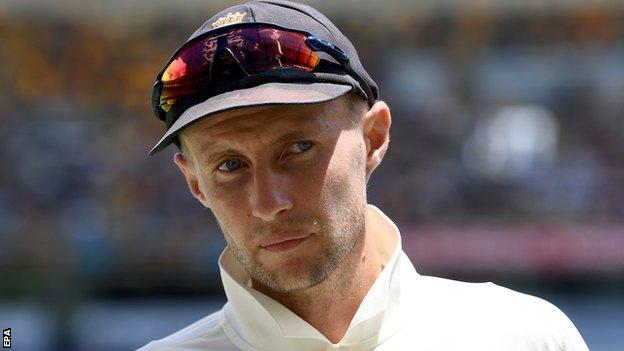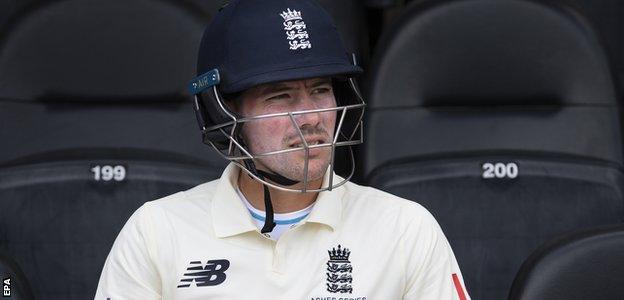ARTICLE AD BOX
 At least Joe Root won the toss at the Gabba...
At least Joe Root won the toss at the Gabba...As Oscar Wilde famously wrote in his little-remembered days as a cricket hack: "To be hammered in one Ashes-opening Brisbane Test may be regarded as unfortunate. To be hammered in seven out of nine Brisbane first Tests over 31 years, and be saved by rain in one of the other two, looks like an unbreakable cricketing habit."
Since a 10-wicket horsing to open the 1990-91 series - a result made even more impressive in the pantheon of Gabba subsidences by the fact England had taken a 42-run first-innings lead - only the epic escape in 2010-11 has interrupted the catalogue of clobberings.
The window of optimism for this year's assault on the urn smashed shut after approximately 0.5 seconds of the series, which is approximately the time it took for the ball to travel from Mitchell Starc's hand to Rory Burns' leg stump, making the Surrey opener the first England player to be bowled out with the first ball of a Test match.
In a desperate attempt to stop all English cricket-lovers replaying that ball in their heads on an endless loop of gloom, here are five statistics to ponder quietly, discuss on Tinder dates, or use as Advent Calendar surprises for your children, as the second Test moves into view.
Joe Root has scored over 1,000 more runs this year than England's second-highest scoring batsman
 Rory Burns is England's second highest Test run-scorer in 2021
Rory Burns is England's second highest Test run-scorer in 2021Recent times have produced many unexpected and unprecedented events around the world that few would or even could have predicted a few years ago.
A Test batsman scoring more than a thousand runs more than his next-most-productive team-mate might not be studied in quite as much depth as other bolts-from-the-blue that have shaken this renowned planet, but it has never happened before, and only once even come close to happening.
Root's tally for the year with two Test remaining stands at 1,544, and Pakistan's Mohammad Yousuf's calendar-year record of 1,788 is within reach.
England's next highest scorer is Burns, with 492, meaning the skipper is set to obliterate the 45-year-old record for Biggest Margin Of Run Superiority By A Player Over His Next Highest-Scoring Team-Mate In A Calendar Year Of Test Cricket.
West Indian immortal Viv Richards outscored Roy Fredericks by 881 runs in 1976, the only other instance of a player exceeding the second most productive member of team by more than 700 runs.
Further numerical evidence of the astonishing chasm between Root and the rest of England's batting is that he has scored more than 3.14 times as many runs as Burns.
Of the 24 players other than Root who have played Tests for England in 2021, only one averages more than 30 - Dawid Malan
England's collective batting average this year is currently 23.6, with seven centuries in 13 Tests.
By nostalgic comparison, in 2011, which began with Andrew Strauss' team sealing a 3-1 series win at the SCG, England's most recent red-ball victory in either Australia (11 Tests) or New Zealand (7 Tests), England scored 16 hundreds in eight Tests and averaged 55.9.
That figure of 23.6 is England's fourth worst since the First World War, outskittled only by 1950 (21.3), 1972 (a year in which England retained the Ashes with a 2-2 draw despite not scoring a century and averaging 23.2), and the famous festival of ineptitude that was 1999, when England managed to squeeze in a collective batting average of 22.3 alongside elimination from a home World Cup before the team song had been released, and the worst ever start to a Test match by a batting team (2-4 in Johannesburg).
Even these startlingly grim numbers have been heavily prettified by Root, who has been papering over some tectonic faults in his team's batting.
If you take out his runs, England's other batters have averaged 18.9, which would be their fourth worst year-average ever, their worst since 1906, and their worst ever in a year containing more than five Tests.
England dismissed Steve Smith in the first innings of a Test for less than 40 for the first time, and for less than 75 for the second time, in 11 matches dating back to August 2015
 Steve Smith endured a rare failure against England in the first Test
Steve Smith endured a rare failure against England in the first TestSmith averaged more than 110 against England in both 2017-18 and 2019 - even Don Bradman did not average 110-plus in two Ashes series.
While England allowed Nathan Lyon to establish himself in the series after a poor showing against India a year ago, they have, for one innings at least, successfully neutralised Smith.
Perhaps the key was to ensure he did not come to the wicket in a crisis situation.
Smith batted seven times in the 2019 series. He came in with Australia two wickets down for less than 30 in six of those innings, and at 60-2 in the other.
In Brisbane, he came in at 166-2, Australia's highest total when he has walked to the crease against England since the third Test in 2013-14, and was swiftly out for 12.
Obviously, this is a tactic that comes loaded with drawbacks, but it showed the benefits of attention to statistical detail in Test match planning, and made sense of David Warner's three ostensibly maddening reprieves.
The team winning the toss at the Gabba has lost the last five Tests there, and won just seven of the last 26 (with five draws and 14 defeats)
 Win the loss and bat at the Gabba? No, Joe... no!
Win the loss and bat at the Gabba? No, Joe... no!Since 1996, 39 grounds have hosted 12 or more Tests, and none has produced a worse win:loss ratio for the toss-winning team than Brisbane.
Pat Cummins' first act as Australia captain was to enjoy the sweet relief of his opponent calling correctly at a Good Toss To Lose™.
Root was the 13th consecutive captain to choose to bat on winning the toss in a Brisbane Test, prior to which, for three decades, most captains chose to bowl first.
In England's unavoidably ill-prepared circumstances, it was a huge gamble, which backfired within one ball as Starc & Physics comprehensively defeated Burns & Rustiness.
Who knows how that Crucial First Hour™ would have panned out had Australia's vulnerable openers - Warner with little red-ball cricket for almost two years, potentially scarred by his 2019 failures, and the unproven Harris - been challenged with negotiating those conditions?
However, with bowling-conducive weather, a green-tinged surface, two of the top four bowlers in the world rankings, and a batting line-up which has been historically unsuccessful, England opted to expose their weaker discipline to their opponents' strong suit in the opening exchange.
Since the Second World War, there have been 20 second Tests between Australia and England in series in Australia. Three have been drawn.
Of the 17 second Tests that produced a winner, the victorious team went on to win the series 16 times.
Ignore everything that has happened. Ignore the doom-laden prognostications of inevitable failure sprouting from a first-Test drubbing. The second Test is the one that really matters in Australia.
The one exception to the otherwise immutable post-war rule that the second-Test winner will take the series was in 1962-63, when England won the second Test, lost the third, and drew the first, fourth and fifth.
England won two of the three series with a drawn second Test (1970-71 and 1986-87), and drew the other (1965-66). In short: not losing second Ashes Tests in Australia is a shrewd strategic masterplan.
The concern for England is that, when Australia wins the first Test of a home Ashes, they tend to win the second as well.
Fourteen of their 15 home-first-Test wins against England since 1920 have been followed by a second-Test win, the gleaming exception being Len Hutton's team in 1954-55, spearheaded by the briefly-flowering pace pyrotechnics of Frank Tyson, who took 25 wickets in England's three consecutive victories after being demolished by an innings and 154 runs at the Gabba.
In short (part 2): not losing second Ashes Tests in Australia when you have lost the first Ashes Test in Australia is a tricky task.
On the positive side for England, Stats do not take the field, and Something That Does Not Usually Happen does actually happen in almost every Test match.
England will have a pink ball under lights, they will have Anderson and Broad returning with more than 1,100 wickets-worth of experience (assuming England do not pull another seriously unwell rabbit from their selectorial hat), and they have the confidence of having successfully followed the Indian blueprint from a year ago of subsiding to a harrowing defeat in the first Test.
Let optimism shunt aside the solemn cloud of history-endorsed probability. At least until Thursday.

 3 years ago
36
3 years ago
36








 English (US) ·
English (US) ·